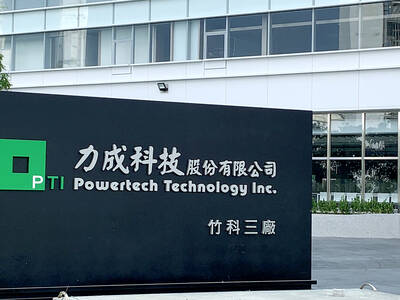Microsoft Corp’s next-generation operating system and the lightweight Ultrabook laptops favored by chip-maker Intel Corp will not be enough to revive growth in the notebook computer sector, Citigroup Inc said yesterday.
Kevin Chang (張凱偉), a Taipei-based analyst for Citigroup, predicted that the annualized growth of notebooks would fall below 5 percent in the long term because tablet computers have eroded demand for notebooks, especially in the replacement market.
“We believe the notebook upgrade cycle is being prolonged due to the rise of tablet PCs,” Chang said at a forum as part of the Semicon Taiwan trade show. “The notebook replacement cycle will get much longer, maybe five years, as hybrid tablets start to replace some consumer notebooks.”
Chang forecast that tablet PC shipments would overtake notebook shipments in developed markets as early as 2014 and no later than 2015.
Speaking on the anticipated release of Windows 8 next month, Chang did not expect consumers to delay purchases of notebooks ahead of the major launch of the touch-friendly operating system.
According to a Citigroup survey, more than 75 percent of consumers have no idea when the Window 8-based notebooks will be available in the market, while only 6 percent said they were holding off on purchasing a notebook in anticipation of the Windows 8 release.
Chang was also skeptical that Ultrabooks would help boost notebook sales because consumers are spending less time at home using notebooks or desktop PCs.
Instead, Windows 8 tablets — with a keyboard docking function — would likely become more attractive to consumers over low-priced Ultrabooks as people prefer using tablets for entertainment, he said.

RUN IT BACK: A succesful first project working with hyperscalers to design chips encouraged MediaTek to start a second project, aiming to hit stride in 2028 MediaTek Inc (聯發科), the world’s biggest smartphone chip supplier, yesterday said it is engaging a second hyperscaler to help design artificial intelligence (AI) accelerators used in data centers following a similar project expected to generate revenue streams soon. The first AI accelerator project is to bring in US$1 billion revenue next year and several billion US dollars more in 2027, MediaTek chief executive officer Rick Tsai (蔡力行) told a virtual investor conference yesterday. The second AI accelerator project is expected to contribute to revenue beginning in 2028, Tsai said. MediaTek yesterday raised its revenue forecast for the global AI accelerator used

Taiwan Semiconductor Manufacturing Co (TSMC, 台積電) has secured three construction permits for its plan to build a state-of-the-art A14 wafer fab in Taichung, and is likely to start construction soon, the Central Taiwan Science Park Bureau said yesterday. Speaking with CNA, Wang Chun-chieh (王俊傑), deputy director general of the science park bureau, said the world’s largest contract chipmaker has received three construction permits — one to build a fab to roll out sophisticated chips, another to build a central utility plant to provide water and electricity for the facility and the other to build three office buildings. With the three permits, TSMC

The DBS Foundation yesterday announced the launch of two flagship programs, “Silver Motion” and “Happier Caregiver, Healthier Seniors,” in partnership with CCILU Ltd, Hondao Senior Citizens’ Welfare Foundation and the Garden of Hope Foundation to help Taiwan face the challenges of a rapidly aging population. The foundation said it would invest S$4.91 million (US$3.8 million) over three years to foster inclusion and resilience in an aging society. “Aging may bring challenges, but it also brings opportunities. With many Asian markets rapidly becoming super-aged, the DBS Foundation is working with a regional ecosystem of like-minded partners across the private, public and people sectors

BREAKTHROUGH TECH: Powertech expects its fan-out PLP system to become mainstream, saying it can offer three-times greater production throughput Chip packaging service provider Powertech Technology Inc (力成科技) plans to more than double its capital expenditures next year to more than NT$40 billion (US$1.31 billion) as demand for its new panel-level packaging (PLP) technology, primarily used in chips for artificial intelligence (AI) applications, has greatly exceeded what it can supply. A significant portion of the budget, about US$1 billion, would be earmarked for fan-out PLP technology, Powertech told investors yesterday. Its heavy investment in fan-out PLP technology over the past 10 years is expected to bear fruit in 2027 after the technology enters volume production, it said, adding that the tech would